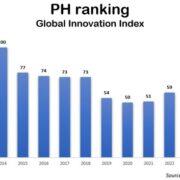The Philippines’ strong economic position prior to the pandemic and improving economic data for the past few months point to an economy on the mend, according to the Philippine government’s economic managers which consist of Socioeconomic Planning Secretary Karl Kendrick T. Chua, Finance Secretary Carlos G. Dominguez, and Budget Secretary Wendel E. Avisado.
As reported by the Philippine Statistics Authority on May 13, the economy improved in the first quarter of 2021 with a slower contraction of 4.2 percent from an 8.3 percent decline in the fourth quarter of 2020. On a seasonally adjusted quarter-on-quarter basis, the economy grew by 0.3 percent.
“This time around, we also have much more latitude. Unlike last year’s enhanced community quarantine (ECQ), the government is taking a more calibrated approach to the present quarantines by addressing the highest sources of risks,” said the economic managers in their joint official statement on the Philippine economic performance for the first quarter of 2021.
On the production side, both industry and services showed smaller contractions, reflecting the recovery, while the decline in agriculture reflects the ongoing crisis in the hog industry. Industry and services continued their gradual recovery, improving from -10.6 percent to -4.7 percent, and from -8.0 percent to -4.4 percent, respectively.
Strong crop production, in particular, rice, helped to improve agriculture performance from -2.5 percent in Q4 2020 to -1.2 percent in Q1 2021.
“However, the livestock industry saw a 23.2 percent drop as the African Swine Fever (ASF) continues to hit the hog industry hard. To address this, the government has been decisive in lowering the tariff rates and increasing the minimum access volume (MAV) for pork as a temporary measure to address the supply deficit and bring down soaring prices of pork,” the economic managers said.
On the expenditure side, growth was driven by government consumption, which increased by 16.1 percent. Public construction also significantly improved by 26.2 percent in Q1 2021, after two consecutive quarterly contractions of -27.1 percent in the third quarter of 2020 and -17.7 percent in fourth quarter of 2020.
“As the economy rebounds in the coming months, we expect business confidence to return, thereby giving private construction further impetus to recover,” they explained.
In addition, with millions regaining their jobs and income sources, household spending improved with a smaller contraction of -4.8 percent from a decline of -7.3 percent in the previous quarter.
The economic managers highlighted that the relaxation of quarantine restrictions while adhering to the minimum health standards enabled millions to regain their jobs and income sources in the first quarter.
As of March 2021, the Philippines has surpassed pre-COVID employment by 2.8 million jobs, as the labor force participation rate improved to 65 percent and the unemployment rate fell to 7.1 percent, the lowest since the height of the pandemic.
While the past seven weeks of ECQ and modified ECQ (MECQ) in the National Capital Region (NCR) Plus area will pose downside risks to growth, the economic managers affirmed that our actions in the next eight months can reverse these initial losses.
According to the joint statement, the country’s growth prospect is underpinned by three important policy actions. First is the safe reopening of the economy. Second is the full implementation of the recovery package. And third is the acceleration of the vaccination program.
“We are working hard to use the present ECQ and MECQ period to improve our health system capacity,” they said.
For instance, data from the Department of Health (DOH) shows that between March 28 and May 10, 2021, intensive care unit (ICU) beds in the country increased from 2,334 to 3,084, while total hospital beds rose from 30,602 to 33,584. In NCR, the center of the present spike, ICU beds increased from 781 to 1,262 and total beds rose from 8,847 to 9,779.
In addition, the government and the private sector are working together to improve contact tracing using automated means, such as the prompt sending of a text message or SMS to close contacts to inform them of the need to quarantine. With this, the government can bring down the gap between virus detection and isolation from 7 to 5.5 days. This could potentially reduce cases by around 51 percent, according to epidemiological models.
“The latest economic performance shows the limits of economic recovery without any major relaxation of our quarantine policy. Thus, once the present spike is over, we can implement quarantine relaxations in a phased approach to boost our recovery this year,” they said.
The economic managers also reiterated the need to fully implement the recovery package, consisting of some 2.76 trillion pesos or 15.4 percent of GDP of fiscal, monetary, and financial resources. The fiscal package includes three budgets that are being implemented together: the Bayanihan 2, the 2020 GAA, and the 2021 GAA, as well as the CREATE law.
“We have also optimized fiscal savings by giving some 22.9 million individuals in the NCR Plus area with 22.9 billion pesos in supplemental social amelioration program (SAP) during the recent ECQ period. We urge Congress to complete the recovery package by immediately passing the Government Financial Institutions Unified Initiatives to Distressed Enterprises for Economic Recovery or GUIDE bill,” they added.
Moreover, they said that the government is accelerating the vaccination program to help boost business and consumer confidence. As of May 9, 2021, more than 2.4 million doses have been administered to our health workers, senior citizens, and persons with comorbidities. Frontline workers in essential economic sectors have also begun to be inoculated.
“We expect to cover even more individuals as 2 million doses of the AstraZeneca vaccine arrived on May 8 and 193,050 doses of the Pfizer vaccine arrived yesterday night. According to the National Task Force against COVID-19, some 27.7 million doses from various sources are expected to arrive by July 2021. All these will help achieve the goal of inoculating 100 percent of our adult population, or some 70 million Filipinos by the end of 2021,” they said.
—
Stay updated with news and information from the National Economic Development Authority by visiting their website at neda.gov.ph.






